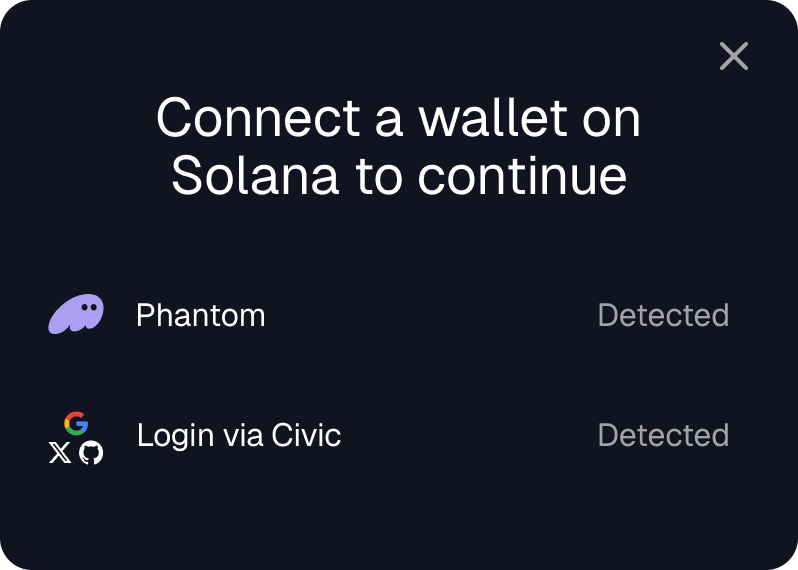How do I get a new Client ID?
How do I get a new Client ID?

Do I need a client secret?
Do I need a client secret?
How do I terminate keys?
How do I terminate keys?
How do I add more authentication methods?
How do I add more authentication methods?
Can my users connect their existing self-managed wallets?
Can my users connect their existing self-managed wallets?
@solana/wallet-adapter-react:
embeddedWallet() wagmi connector alongside other connectors like Metamask, so your code can switch between Civic embedded wallets and the user’s other installed wallets. Currently those wallets cannot be linked to the Civic account, they are separate.How are these wallets managed?
How are these wallets managed?
Does Civic own these wallets?
Does Civic own these wallets?
Will users get private keys?
Will users get private keys?
What happens if users lose their SSO access?
What happens if users lose their SSO access?
Can I test Civic Auth before going live in production?
Can I test Civic Auth before going live in production?
What domains need to be registered for apps?
What domains need to be registered for apps?
- Your application’s domain(s) (e.g.,
https://myapp.com) - Your OAuth callback URLs for backend integrations (e.g.,
https://myapp.com/auth/callback)
loginSuccessUrl parameter (used to redirect users to a specific page after login) does not need to be registered separately - it’s used for navigation within your already-registered domain.How do I redirect my users to a specific page after login?
How do I redirect my users to a specific page after login?
Backend Frameworks (Express, Fastify, Hono)
Use theloginSuccessUrl configuration parameter:redirectUrlis the OAuth callback where Civic redirects to complete authentication- After your backend processes the callback, it redirects the user to
loginSuccessUrl
Next.js
Use theloginSuccessUrl configuration parameter in your Next.js config:React / Single Page Applications (SPAs)
Important:loginSuccessUrl is not supported for React or frontend-only SPAs. Instead, use the onSignIn hook:How can I monitor usage for Civic Auth?
How can I monitor usage for Civic Auth?
How do I debug Civic Auth integration issues?
How do I debug Civic Auth integration issues?
- A clear description of exactly what you’re trying to achieve and the issue you’re encountering in doing so
- At which step in the implementation does the issue arise
- Screenshots of the error or unexpected behavior
- Relevant snippets of your code, especially the sections interacting with Civic Auth.
- Any error messages from the Console and/or Network tabs
How do I report bugs or request new features?
How do I report bugs or request new features?
How do I invite team members?
How do I invite team members?
How do I customize my logo?
How do I customize my logo?
Can I restrict certain wallets or block specific users?
Can I restrict certain wallets or block specific users?

